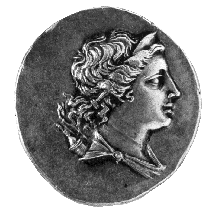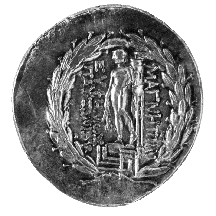



(48) Magnesia-on-Maeander, Ionia - AR tetradrachm, 155-140 B.C.,
16.77 g. (inv. 91.082).
Obverse: Bust of Artemis r., wearing stephane, bow,
and quiver over l. shoulder.
Reverse: Within wreath, nude Apollo standing l. on maeander,
leaning on tripod to his l., filleted branch in r.; to l., ![]()
![]() : Euphemos Pausaniou; to r.,
: Euphemos Pausaniou; to r., ![]() : of the Magnesians.
: of the Magnesians.
Provenance: Münzen und Medaillen, 1973.
Bibliography: N.F. Jones, "The Autonomous Wreathed
Tetradrachms of Magnesia-on- Maeander," American Numismatic Society
Museum Notes 24 (1979) 63-109.
Magnesia-on-Maeander was an old Ionian city once located on the river Maeander,
which is now silted up. In antiquity it was famous for its sanctuary of
Artemis Leukophryene. It was made autonomous in the Treaty of Apamea in
188 B.C. and issued its own wreathed tetradrachms in the middle of the second
century.
The obverse of the tetradrachms depicts a bust of Artemis wearing a stephane
or crown and with her attributes, a quiver and bow, at her left shoulder.
It was typical of the autonomous cities of the period to abandon portraits
of Alexander and his royal successors and to resume use of the cities' main
deities on their obverses. On the reverse is Artemis' brother, Apollo, also
worshipped at Magnesia. He stands on the maeander, emblem of the city. To
the left is the name Euphemos
Pausaniou (Ephemos, son of Pausanias), one of eight names occurring on the
reverses of Magnesia's tetradrachms. The significance of these men for the
coinage of Magnesia is unclear. It has been suggested that they were officials
of the mint or that they were liturgists, wealthy men who contributed materially
to the city, in this case to the production of its coins, and who were then
honored with the appearance of their names on the reverses. Euphemos may
be the same man, apparently a prominent citizen of Magnesia, who was the
recipient of a Magnesian honorary decree of uncertain date and who was a
temple steward of the cult of Artemis Leukophryene in 138 or 132 B.C. The
evidence of the seven hoards in which the Magnesian wreathed tetradrachms
have been found suggests that they were issued from c. 155-140 B.C.
C.L.L.



All contents copyright (c) 1996.
Lawrence University
All rights reserved.